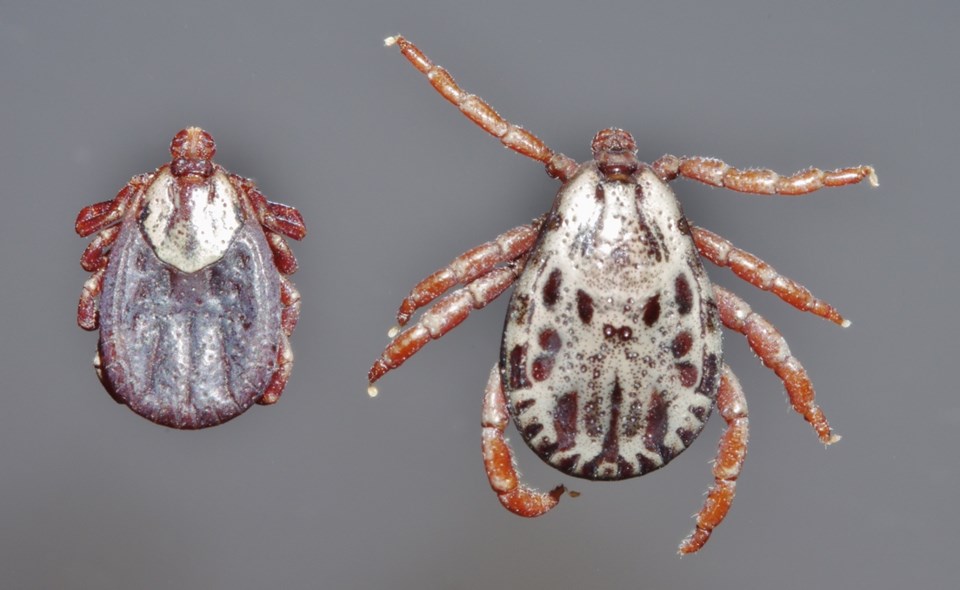You are not done with those creepy, crawly pests that burrow under your skin and cause pain, irritation or worse.
Not content to be just warm weather nuisances, ticks are an even bigger long term risk these days, say scientists. New research shows they are more pervasive than ever in areas including Boulder County and not going away just because of colder temperatures.
In fact, ticks carrying diseases, including Rocky Mountain spotted fever, Colorado tick fever and the neurotoxin that causes tick-borne paralysis, pose an emerging threat in Colorado, according to a news release from the Bay Area Lyme Foundation.
The foundation cites a study published in the November issue of the peer-reviewed journal “Ticks and Tick-borne Diseases” that shows American dog ticks are very much present in 16 counties in Colorado, where they were not previously identified by the Centers for Disease Control.
Rocky Mountain wood ticks are found in 38 of the 64 Colorado counties, where before they had only been identified in only 33 counties.
Emma Harris, research scientist with Colorado State University’s Center for Vector-Borne Infectious Diseases, said she is familiar with the study and is not surprised by the results.
Ticks are resilient even in the coldest environments and hang around long after the summer and fall are over. They can quickly jump on unwilling hosts like people and dogs out hiking on local trails, Harris said.
“Ticks are quite complex and they have an incredible life cycle,” Harris said. “They can live off their hosts for long periods of time.”
Avid hikers or even weekend strollers should dress accordingly and wear long sleeves and long pants tucked into boots to prevent ticks from crawling into the tiniest human crevice, she said. People should also check themselves, their partners and pets almost immediately after brushing up against nature, Harris said.
A warming climate is inviting more people to hike and camp later in the season, Harris said, adding to more tick encounters.
“The ticks have always been there,” she said. “You just have to be prepared for them and take precautions.”
The tick study was leveraged by several sources, including ticks collected by citizen scientists as part of a free tick testing program offered by the Bay Area Lyme Foundation, according to the news release.
“It really was amazing,” Harris said. “People collected ticks from themselves and their dogs and gave them to labs to be analyzed. That’s why it was so comprehensive.”
“The critical takeaway from this study is that Coloradans need to take preventative measures against ticks when outdoors, such as tick checks, and doctors should be more vigilant for symptoms of tick-borne diseases including those carried by Rocky Mountain wood ticks and American dog ticks,” said Linda Giampa, executive director, Bay Area Lyme Foundation, in the news release. “This ecology study illustrates the power of leveraging citizen science, and we are grateful for the more than 20,000 ticks that were submitted to our national program and made this study possible.”
Conducted by researchers from Colorado State University and funded by the Bay Area Lyme Foundation, the study aimed to quantify the current county-level distribution of Rocky Mountain wood ticks, Dermacentor andersoni, and American dog ticks, Dermacentor variabilis. The study evaluated data from ticks collected by the citizen scientists and evaluated at Northern Arizona University as part of Bay Area Lyme Foundation’s Free Tick Testing program, distribution data from the Colorado Department of Public Health and the Environment, veterinary surveillance at Oklahoma State University, and literature data, the news release states.
“It was interesting to us to see American dog ticks in unexpected counties in Colorado which appear to be invading from nearby states or traveling with people and pets. And also to show that Rocky Mountain wood ticks appear, for the most part, to inhabit counties at higher elevations than American dog ticks,” said co-author Daniel Salkeld, PhD, Colorado State University, in the news release. “This study is a red flag that, on the county-level, it is necessary to increase tick surveillance locally, and, on an individual level, to take precautions and know the symptoms of tick-borne diseases.”
Rocky Mountain wood ticks and American dog ticks are both known carriers of Rickettsia rickettsii which causes Rocky Mountain spotted fever, a disease that is on the rise in the US, and Francisella tularensis which causes tularemia, a potentially life-threatening disease that has seen a spike in incidence in recent data, and can cause tick-borne paralysis, the news release states.
According to this study, both species of tick were found on humans and dogs. Rocky Mountain wood ticks appear to be more attracted to humans, with this tick representing 58% of ticks attached to humans, compared to the American dog tick, which represented 92% of ticks attached to dogs.
“The citizen science approach has been critical to supporting our efforts as widespread active surveillance programs in Colorado have had difficulty due to the state's diverse terrain and no Colorado counties regularly conduct these,” said lead author Elizabeth Freeman, MPH, Colorado State University in the news release. “With the knowledge that there is a risk of encountering both the Rocky Mountain wood tick and American dog tick in Colorado, there should be more motivation to further enhance surveillance studies to fully understand the public's risk of disease.”
The research was conducted through a partnership between Bay Area Lyme Foundation, Northern Arizona University, Colorado State University and the Translational Genomics Research Institute (TGen). Interactive maps show the distribution by county of the tick species collected, including western blacklegged tick, blacklegged tick, American dog tick, lone star tick. Prevalence of Rocky Mountain wood ticks in this study were not previously evaluated and reported, the news release states.


